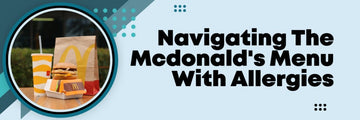Blog
Living Life With A Wheat Intolerance
by
Dr. Joseph Nightingale
on
Aug 28, 2024
Living with a wheat intolerance or allergy is among the most challenging food intolerances – especially in Western nations. Wheat is a staple food in the UK, found in bread, pasta, baked goods, couscous, and even soy sauce and ice cream.
In fact, 99.8% of British households buy bread, and nearly 11 million loaves are sold daily.
Avoiding wheat is the primary way to treat wheat intolerance. But with so many foods containing wheat, that's more challenging than it sounds. Wheat intolerance is also confused with coeliac disease, non-coeliac gluten sensitivity, and other similar conditions.
What is Wheat Intolerance?
Wheat intolerance is a condition where individuals experience digestive or system symptoms after consuming wheat or its derivatives.
Unlike coeliac disease, which is an autoimmune disease, wheat intolerance can be caused by other components of wheat than gluten. Nor are individuals with the intolerance susceptible to other gluten-containing grains like rye or barley.
Symptoms of wheat intolerance:
- Bloating and gas
- Abdominal pain
- Diarrhoea or constipation
- Headaches or migraines
- Fatigue
- Skin rashes, such as eczema or hives
- Nasal congestion or sinus issues
- Joint pain
- Mood swings or irritability
- Nausea or vomiting
Wheat Intolerance and Allergies: What's the Difference?
There's a lot of confusion surrounding
wheat intolerances, allergies, and other conditions. Little wonder, considering it plays a central role in numerous dietary problems. Let's clear up some terms:
 Wheat intolerance
Wheat intolerance, as explained, is primarily a digestive response to specific components in wheat, resulting in bloating and abdominal discomfort.
In contrast,
wheat allergy is a true allergic reaction to proteins found in wheat. Individuals undergo an allergic reaction, including hives, swelling, breathing difficulty, and even anaphylaxis (a life-threatening condition). The production of IgE antibodies and the release of histamine due to wheat proteins are characteristics of a wheat allergy.
Coeliac disease is an autoimmune disorder where the consumption of gluten, a protein in wheat, barley, and rye, prompts the immune system to attack the small intestine's lining. Symptoms can range broadly, including digestive issues, skin rashes, fatigue, and nutritional deficiencies.
Last,
non-coeliac gluten sensitivity involves activation of the innate immune system but is not an allergic or autoimmune reaction. Symptoms are usually milder than other conditions, including fatigue, brain fog, and digestive issues.
How to Manage a Wheat Intolerance
Living life with a wheat intolerance is daunting. The biggest question individuals ask is, "What can I eat?" From bread to pastries, pasta to cereals, wheat is omnipresent. However, understanding the condition, adapting your lifestyle, and exploring other food options can make the journey not just manageable but enjoyable.
Foods to Avoid:
- Bread, pasta, and cereals that contain wheat.
- Processed foods that list wheat or wheat derivatives as ingredients.
- Some sauces and gravies can use wheat as a thickener.
- Certain alcoholic beverages, like beer or spirits, might be distilled from wheat.
- Baked goods like cakes, cookies, and pastries unless specified as wheat-free.
Foods to Enjoy:
- Grains like quinoa, rice, corn, and oats (ensure they are not cross-contaminated).
- Flours such as almond, coconut, chickpea, and rice can be used in baking and cooking.
- Fresh fruits and vegetables.
- Meat, fish, and poultry that aren't breaded or fried with wheat-containing products.
- Dairy products, but be wary of any that might have added ingredients derived from wheat.
Eating Out and Social Events
Restaurants pose a significant challenge for people with a wheat intolerance (or similar dietary conditions). As coeliac disease and gluten sensitivity become more common, gluten-free (and thus wheat-free) options are becoming more increasing.
Open communication with restaurant staff is key. Explain what you can and can't eat, and they'll advise on the best options. Remember, you're not gluten intolerant. So, foods containing oats, barley, or rye are 100% fine.
Social events are another conundrum. At some point, everyone with wheat intolerance will encounter a well-meaning friend who mistakenly assures them a meal is wheat-free, only to realise the error later.
Consider bringing a wheat-free dish to share. It not only guarantees you'll have something to eat but also introduces others to some wheat-free specialities.
Closing Thoughts
Any dietary intolerance is a headache to live with. However, wheat intolerance might be the most troublesome of the bunch. It's even harder if you're unsure whether you're allergic or intolerant to wheat.
That's where our Allergy Test comes in. Using ELISA testing for raised IgE antibodies, it checks your blood sample for 38 common allergies, including wheat. And you'll receive your results back in a week.
Don't stay in the dark about what's causing your discomfort. Take control of your health and ensure a better, symptom-free future. Order your
Allergy Test today and begin your journey to a clearer understanding of your body's reactions.
 Wheat intolerance, as explained, is primarily a digestive response to specific components in wheat, resulting in bloating and abdominal discomfort.
In contrast, wheat allergy is a true allergic reaction to proteins found in wheat. Individuals undergo an allergic reaction, including hives, swelling, breathing difficulty, and even anaphylaxis (a life-threatening condition). The production of IgE antibodies and the release of histamine due to wheat proteins are characteristics of a wheat allergy.
Coeliac disease is an autoimmune disorder where the consumption of gluten, a protein in wheat, barley, and rye, prompts the immune system to attack the small intestine's lining. Symptoms can range broadly, including digestive issues, skin rashes, fatigue, and nutritional deficiencies.
Last, non-coeliac gluten sensitivity involves activation of the innate immune system but is not an allergic or autoimmune reaction. Symptoms are usually milder than other conditions, including fatigue, brain fog, and digestive issues.
Wheat intolerance, as explained, is primarily a digestive response to specific components in wheat, resulting in bloating and abdominal discomfort.
In contrast, wheat allergy is a true allergic reaction to proteins found in wheat. Individuals undergo an allergic reaction, including hives, swelling, breathing difficulty, and even anaphylaxis (a life-threatening condition). The production of IgE antibodies and the release of histamine due to wheat proteins are characteristics of a wheat allergy.
Coeliac disease is an autoimmune disorder where the consumption of gluten, a protein in wheat, barley, and rye, prompts the immune system to attack the small intestine's lining. Symptoms can range broadly, including digestive issues, skin rashes, fatigue, and nutritional deficiencies.
Last, non-coeliac gluten sensitivity involves activation of the innate immune system but is not an allergic or autoimmune reaction. Symptoms are usually milder than other conditions, including fatigue, brain fog, and digestive issues.














